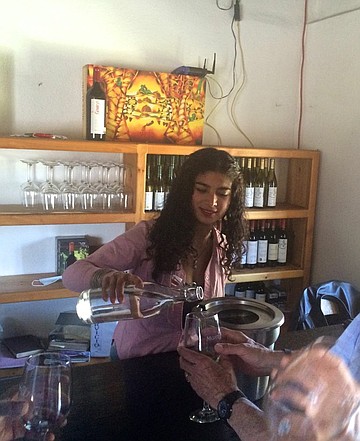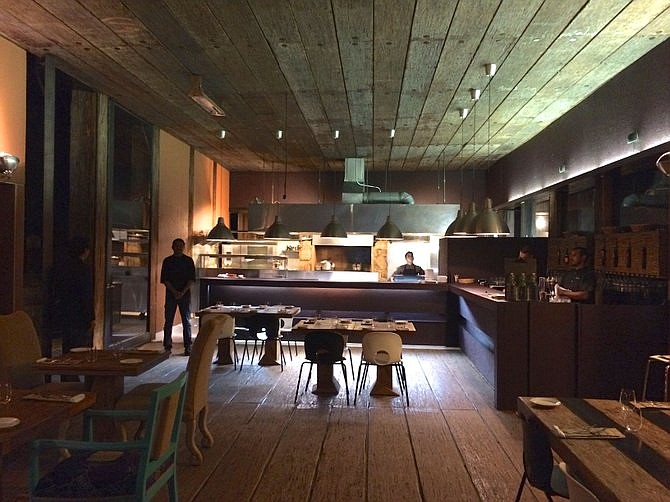 Facebook
Facebook
 X
X
 Instagram
Instagram
 TikTok
TikTok
 Youtube
Youtube


Recently I went back to northern Baja's Guadalupe Valley. I hadn’t been there since the late 1980s. Back then, it was just emerging as a serious wine-growing region, with two giant producers (Cetto and Pedro Domecq) and a half-dozen earnest start-ups. The area seemed filled with promise. But one distraction after another – personal and geopolitical – kept getting in the way of my returning even once.
So returning 25 years later felt a little like journeying in a time machine. The valley looked very much like it did when I last saw it: quiet, bucolic, agriculturally industrious.

Astonishing changes have also unfolded, however. Instead of eight wineries, more than 60 operate. Domecq, whose presence once seemed predominant, has been acquired by the huge French brandy maker Bernard Ricart and is no longer making wine under its own brands. But the giant L.A. Cetto has built its own baronial tasting room jammed with a great variety of labels. A trickle of American cruise ship passengers who’ve stopped in Ensenada find their way here, along with some day-trippers from north of the border.
The growers say the vast majority of the wine tourists are now Mexicans. The cracks in the country’s drinking culture that were just appearing a quarter-century ago became a seismic shift.
In my earlier research, I’d learned the sad story of why Mexico for so long failed to develop a serious wine culture. By all rights, it should have. Hernando Cortez had Spanish ships bring vines and seeds to Veracruz almost as soon as he arrived, and he’d ordered all Spaniards with land grants to plant grapevines for five years. By 1554 wine growing was well established at haciendas as far west as the present state of Michoacán, and the first commercial winery was established in 1593 in Coahuila.
But then regulatory catastrophe struck. Disturbed by the shrinking shipments of Spanish wine to New Spain, Philip II decided in 1595 to tighten his country’s grip in the trade, and he banned any new plantings. Over the course of the next 200 years, subsequent viceroys even ordered existing vineyards to be destroyed. So it was that Mexico became the land of cactus liquor rather than cabernet.
Yet excellent cabernet grapes grow in the coastal valleys – as do syrah, tempranillo, merlot, malbec, and literally dozens of other French, Spanish, Italian, German and other varieties. (Nebbiolo is said to be particularly well-suited to the Guadalupe Valley.)
On my recent visit, I was traveling with a small group of friends, some blessed with more discerning and practiced palates than mine. While they still sneer at the produce of Temecula and Ramona, they were respectful and impressed by a lot of what we sampled in Baja.
We only scratched the surface, staying for two nights at Adobe Guadalupe. As a lodge, it’s tiny (only six guest rooms), but as a winery it produces a respectable 7,000–8,000 cases per year. (For added charm, the owner also breeds show horses that are sold to buyers around the world.)

Over the course of two days, we tasted wine at Adobe Guadalupe and three other wineries, including a newish one called Las Nubes. Almost more impressive than the wineries was the food we ate.

Some superb examples of Baja Med cuisine are being practiced in the valley. One dark night we drove through plantings of grapes to get to Corazon de Tierra. The seven-course tasting menu there made it clear why it was included recently in a list of the top 50 restaurants in Latin America. But our three-hour lunch the next day at the well-established Laja was even more dazzling. A roasted bone marrow amuse bouche, creamy corn with local sea urchin, and pork head with sun choke puree were among the stand-outs – but in truth, every bite of virtually everything was sublime.
Such pleasures seemed a million miles from narcocriminal terrorism of the sort that still makes so many Americans afraid to venture to Baja. The recent collapse of the toll road to Ensenada (said to be months away from being repair) would seem to be yet another impediment to getting to the valley.
But not if you go through Tecate, as we did. It’s an easy hour-or-so drive from central San Diego to the border crossing there. We breezed through and enjoyed a quick lunch in the charming town, after which the drive to the wine country took another stress-free hour or so. Even coming back through Tecate seemed a throwback to a simpler, kinder time: the wait was less than 5 minutes.
Knowing what I now know, it certainly won’t be another quarter century till I go back.



Recently I went back to northern Baja's Guadalupe Valley. I hadn’t been there since the late 1980s. Back then, it was just emerging as a serious wine-growing region, with two giant producers (Cetto and Pedro Domecq) and a half-dozen earnest start-ups. The area seemed filled with promise. But one distraction after another – personal and geopolitical – kept getting in the way of my returning even once.
So returning 25 years later felt a little like journeying in a time machine. The valley looked very much like it did when I last saw it: quiet, bucolic, agriculturally industrious.

Astonishing changes have also unfolded, however. Instead of eight wineries, more than 60 operate. Domecq, whose presence once seemed predominant, has been acquired by the huge French brandy maker Bernard Ricart and is no longer making wine under its own brands. But the giant L.A. Cetto has built its own baronial tasting room jammed with a great variety of labels. A trickle of American cruise ship passengers who’ve stopped in Ensenada find their way here, along with some day-trippers from north of the border.
The growers say the vast majority of the wine tourists are now Mexicans. The cracks in the country’s drinking culture that were just appearing a quarter-century ago became a seismic shift.
In my earlier research, I’d learned the sad story of why Mexico for so long failed to develop a serious wine culture. By all rights, it should have. Hernando Cortez had Spanish ships bring vines and seeds to Veracruz almost as soon as he arrived, and he’d ordered all Spaniards with land grants to plant grapevines for five years. By 1554 wine growing was well established at haciendas as far west as the present state of Michoacán, and the first commercial winery was established in 1593 in Coahuila.
But then regulatory catastrophe struck. Disturbed by the shrinking shipments of Spanish wine to New Spain, Philip II decided in 1595 to tighten his country’s grip in the trade, and he banned any new plantings. Over the course of the next 200 years, subsequent viceroys even ordered existing vineyards to be destroyed. So it was that Mexico became the land of cactus liquor rather than cabernet.
Yet excellent cabernet grapes grow in the coastal valleys – as do syrah, tempranillo, merlot, malbec, and literally dozens of other French, Spanish, Italian, German and other varieties. (Nebbiolo is said to be particularly well-suited to the Guadalupe Valley.)
On my recent visit, I was traveling with a small group of friends, some blessed with more discerning and practiced palates than mine. While they still sneer at the produce of Temecula and Ramona, they were respectful and impressed by a lot of what we sampled in Baja.
We only scratched the surface, staying for two nights at Adobe Guadalupe. As a lodge, it’s tiny (only six guest rooms), but as a winery it produces a respectable 7,000–8,000 cases per year. (For added charm, the owner also breeds show horses that are sold to buyers around the world.)

Over the course of two days, we tasted wine at Adobe Guadalupe and three other wineries, including a newish one called Las Nubes. Almost more impressive than the wineries was the food we ate.

Some superb examples of Baja Med cuisine are being practiced in the valley. One dark night we drove through plantings of grapes to get to Corazon de Tierra. The seven-course tasting menu there made it clear why it was included recently in a list of the top 50 restaurants in Latin America. But our three-hour lunch the next day at the well-established Laja was even more dazzling. A roasted bone marrow amuse bouche, creamy corn with local sea urchin, and pork head with sun choke puree were among the stand-outs – but in truth, every bite of virtually everything was sublime.
Such pleasures seemed a million miles from narcocriminal terrorism of the sort that still makes so many Americans afraid to venture to Baja. The recent collapse of the toll road to Ensenada (said to be months away from being repair) would seem to be yet another impediment to getting to the valley.
But not if you go through Tecate, as we did. It’s an easy hour-or-so drive from central San Diego to the border crossing there. We breezed through and enjoyed a quick lunch in the charming town, after which the drive to the wine country took another stress-free hour or so. Even coming back through Tecate seemed a throwback to a simpler, kinder time: the wait was less than 5 minutes.
Knowing what I now know, it certainly won’t be another quarter century till I go back.
Comments